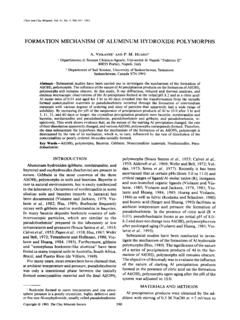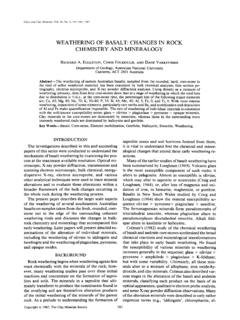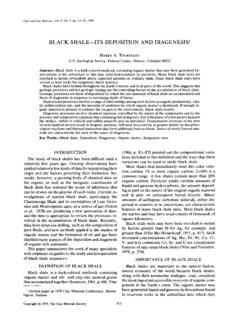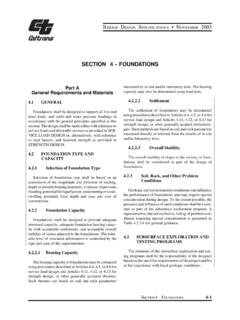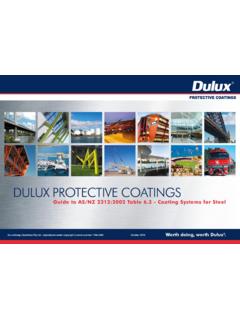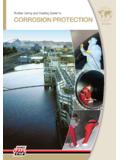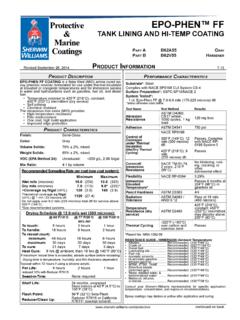Transcription of GEOLOGY AND MINERALOGY OF THE …
1 GEOLOGY AND MINERALOGY OF THE sedimentary KAOLINS OF THE SOUTHEASTERN UNITED STATES--A REVIEW* by THOMAS F. BATES The Pennsylvania State University, University Park, Pennsylvania ABSTRACT Beginning with the work of Ladd in 1898, much has been written about the kaolins of the Southeast, with maximum coverage on the deposits of greatest economic value. Early studies were, of necessity, general in nature but also contain excellent detailed descriptions. In the past 1S years increased demands for kaolins to meet specific requirements have resulted in a large amount of detailed research, much of it unpublished. This paper attempts to review the available information placing emphasis upon the geologic and mineralogical data and the interpretation thereof with respect to the occurrence, detailed character and variability, and probable origin of the clay deposits.
2 The commercial deposits of kaolin clay discussed herein lie throughout the sands of the Upper Cretaceous Tuscaloosa formation and are localized in a narrow belt along the southeast edge of the "fall line" from Macon, Georgia, to Aiken, South Carolina. The kaolin lenses are irregular in shape, size and purity, ranging from a few feet to a mile in length, and up to 50 ft in thickness. Variability within the lenses is a function of (1) the concentration and localization of non-clay materials (quartz, mica, gibbsite, pyrite, lignite; Fe2Os, TiO,, MnO), (2) the montmorillonite content, (3) the particle size and X-ray crystallinity of the kaolinite, and (4) the texture of the clay aggregate. These mineralogical, chemical and textural variables are not homogeneously distributed but reveal and help to explain differences between samples, layers, pits and the important hard and soft clay types of the region.
3 INTRODUCTION AS pointed out by Heinrich Ries (1927) in his famous work Clays, their occurrence, properties and uses, "The term kaolin was originally used to refer to white residual clays of a white or nearly white burning character, but in recent years it has been stretched to cover certain white sedimentary clays like those obtained in South Carolina and Georgia." I have used the term kaolin, rather than kaolinite, in the title of this review not only in recognition of former practice, but also because it points to the fact that * Contribution No. 63-60 from the College of Mineral Industries, The Pennsylvania State University. 177 178 TWELFTH NATIONAL CONFERENCE ON CLAYS AND CLAY MINERALS the clays to be discussed are not monomineralic.
4 Much of the variability between and within the deposits is the result of variation in the nature and quantity of minerals other than kaolinite, such as mica, quartz, varieties of TiO,, pyrite and the clay mineral montmorillonite. The common practice of beneficiating the clays by washing is testimony to their naturally impure state even though, as so ably expressed by Veatch (1909, ), "it would seem that nature operated a clay washing plant on a grand scale" ill the original separation of the fine from the coarse fraction of the enclosing sands. The clay mineral kaolinite, though not infrequently found as pseudo- morphs after a wide variety of silicate and even non-silicate minerals, is, on a quantitative basis, believed to be derived largely from the weathering of feldspar and Al-mica.
5 It occurs in all types of sedimentary rocks and is particularly common in association with arkoses and the related silts and shales (Krynine, 1948, ). A sedimentary deposit of commercial im- portance may be produced where conditions are favorable for an adequate amount of the clay to be separated from associated non-clay material, deposited without appreciable "dilution" by other detritus or chemical precipitates and preserved from subsequent alteration or erosion. It is to be expected that for every "commercial deposit" there will be many associated non-commercial clay concentrations having all degrees of purity and ranging from miles to feet in size. Since the literature on the sedimentary kaolins of the southeastern United States is concerned primarily with the commercial clays, any review of the literature presents only part of the entire geological and mineralogical picture.
6 This particular review is further limited to a discussion of the kaolins in the Upper Cretaceous Tuscaloosa formation of Georgia and South Carolina. LITERATURE Although reference to the clays under consideration is to be found in early geological studies of the region, the first detailed description was that of George E. Ladd published in 1898 as a Georgia Geological Survey bulletin. In Georgia his work was followed by the comprehensive studies of J. O. Veatch (1908, 1909), while in South Carolina a preliminary report was made by Sloan (1904). The work of Veatch stands, even today, as an authoritative, informative description of the GEOLOGY and MINERALOGY of the exposures and pits accessible in the early days of the century; and many of his concepts as to the origin of the clays have been subscribed to by later workers.
7 While Veatch was occupied with the clays, his colleague L. W. Stephenson (1911, 1914) was engaged with the problem of placing them in proper stratigraphic relationship to associated lithologic units, a task undertaken in earlier days by Smith and Johnson (1887) who had originally named the Tuscaloosa formation. GEOLOGY AND MINERALOGY OF THE sedimentary KAOLINS 179 Ries (1903, 1922, 1927) described, in increasing detail, the Cretaceous coastal plain clays of Georgia and South Carolina, and put them in proper perspective with other clays in these and other states with respect to their known geographic position, geologic occurrence, apparent mineralogi- cal character and commercial importance. With the development of the kaolin industry and greater recognition of its economic importance to the region, came an increasing amount of work, which has continued to the present day, on the exploration, properties, processing, and utilization of the clays ( , Weigel, 1922, 1925; Stull and Bole, 1936; Henry and Vaughan, 1937; Lang, 1940; Thompson, 1943; Warren and Thompson, 1943; Klinefelter et al.)
8 , 1943; Kesler, 1951; Wood- ward, 1955; Murray, 1963). A recently issued bibliography on "High alumina kaolinitic clay of the United States" (Mark, 1963) contains many useful references pertinent to the clays considered here. Concurrent studies emphasizing stratigraphic relationships but often including descriptions and discussions of probable origin of the clays have been numerous. Among them are the following: Cooke, 1926, 1936, 1943; Neumann, 1927; Smith, 1929; Stephenson et al., 1942; Munyan, 1943; LaMoreaux, 1946; Eargle, 1955; and Le Grand and Furcron, 1956. Discussions of the MINERALOGY of the clays and associated sediments and chemical analyses of the clay are to be found in many of the references already given, as for example in Veatch (1908, 1909), Stull and Bole (1926), Neumann (1927) and Smith (1929).
9 The classic paper of Ross and Kerr (1930) revealed the applicability of the X-ray diffraction technique to the study of the kaolin minerals and discussed many aspects of their characterization and formation. Although only one sample from the Georgia-South Carolina belt was included, this work provided much information basic to subsequent studies on these kaolins. Particularly noteworthy, among such studies, have been those of Klinefelter, O'Meara, Truesdell, and Gottlieb (1943), Mitchell and Henry (1943), Kerr and his associates on Research Project 49 of the American Petroleum Institute (1949, 1950), and Hinckley (1961, 1963). The Bureau of Mines publication by Klinefelter et al. (1943) reports the results of the comprehensive analysis of 18 selected specimens by mineralogical, chemical and physical testing procedures.
10 This work pro- vided important evidence as to differences between the hard and soft clay types of the region, as represented by a limited number of samples. In- dependent work of Mitchell and Henry published in the same year (1943) also revealed differences between hard and soft samples, and, together with the previous work cited, may be considered a major step forward in the continuing attempt to relate physical behavior of the clays to their mineralogical and chemical properties. The work of contributors to American Petroleum Institute Project number 49 resulted in a mass of mineralogical and chemical data on a large number of clay specimens, including four samples from the Macon, 180 TWELFTH NATIONAL CONFERENCE ON CLAYS AND CLAY MINERALS Georgia, area and four from Bath, South Carolina.

